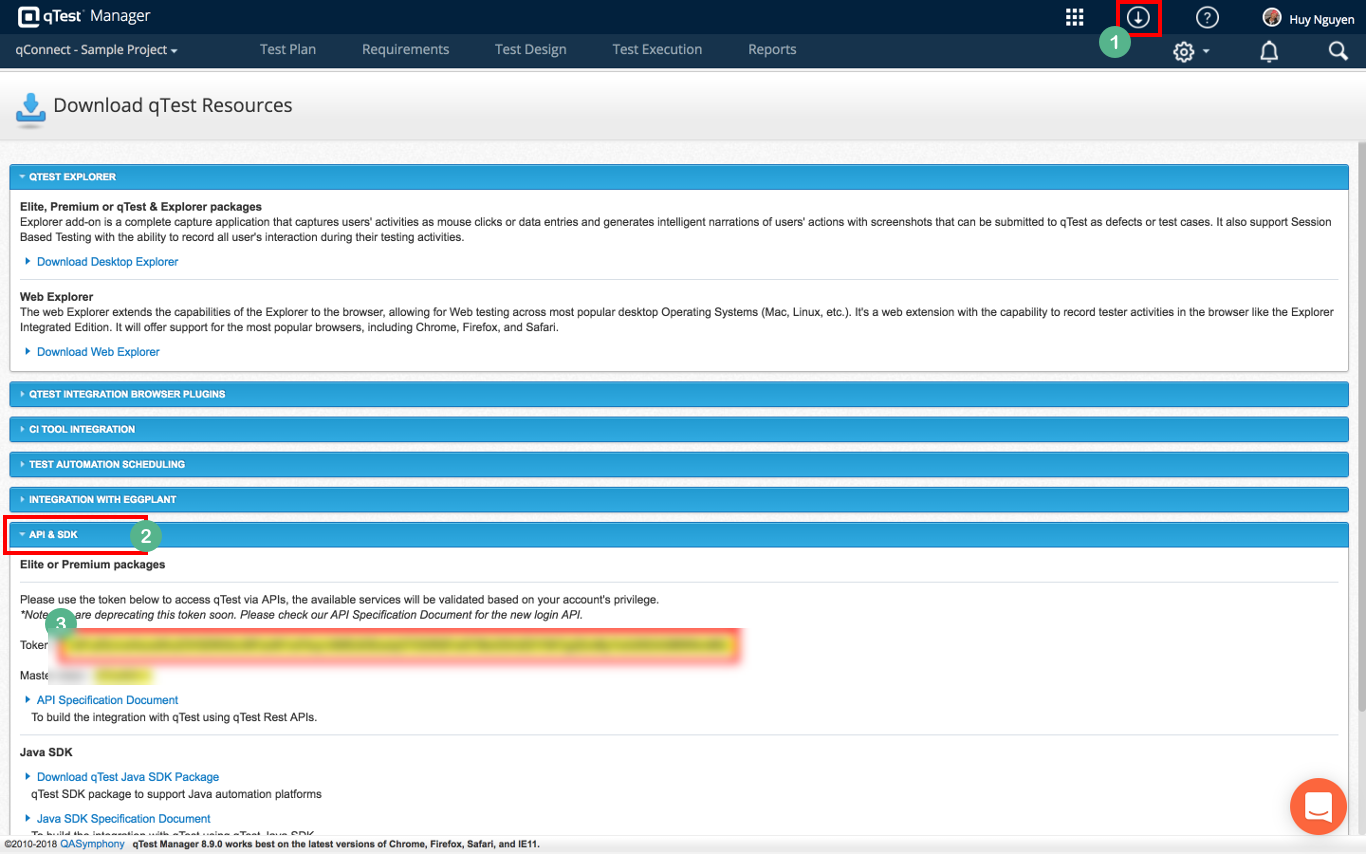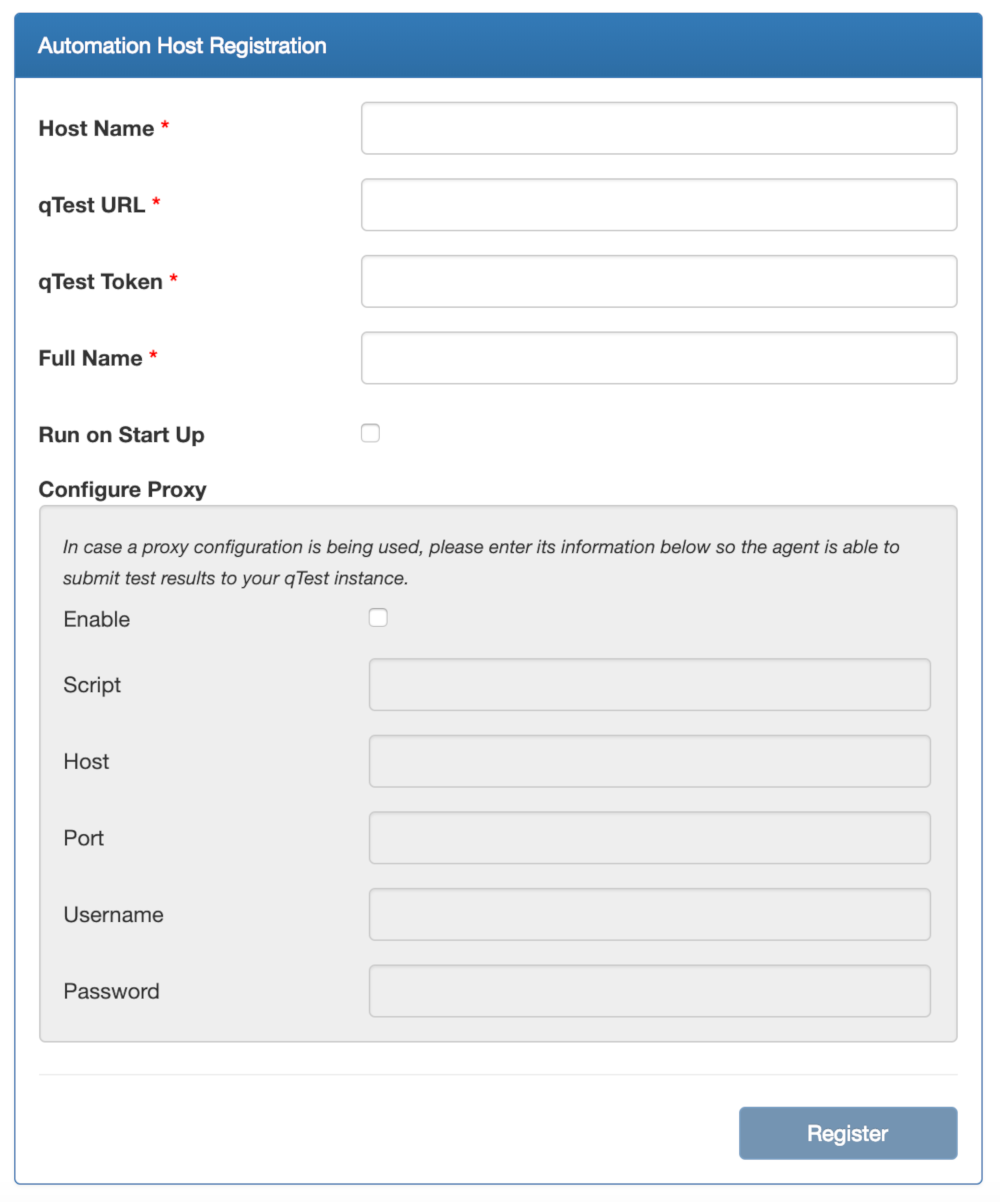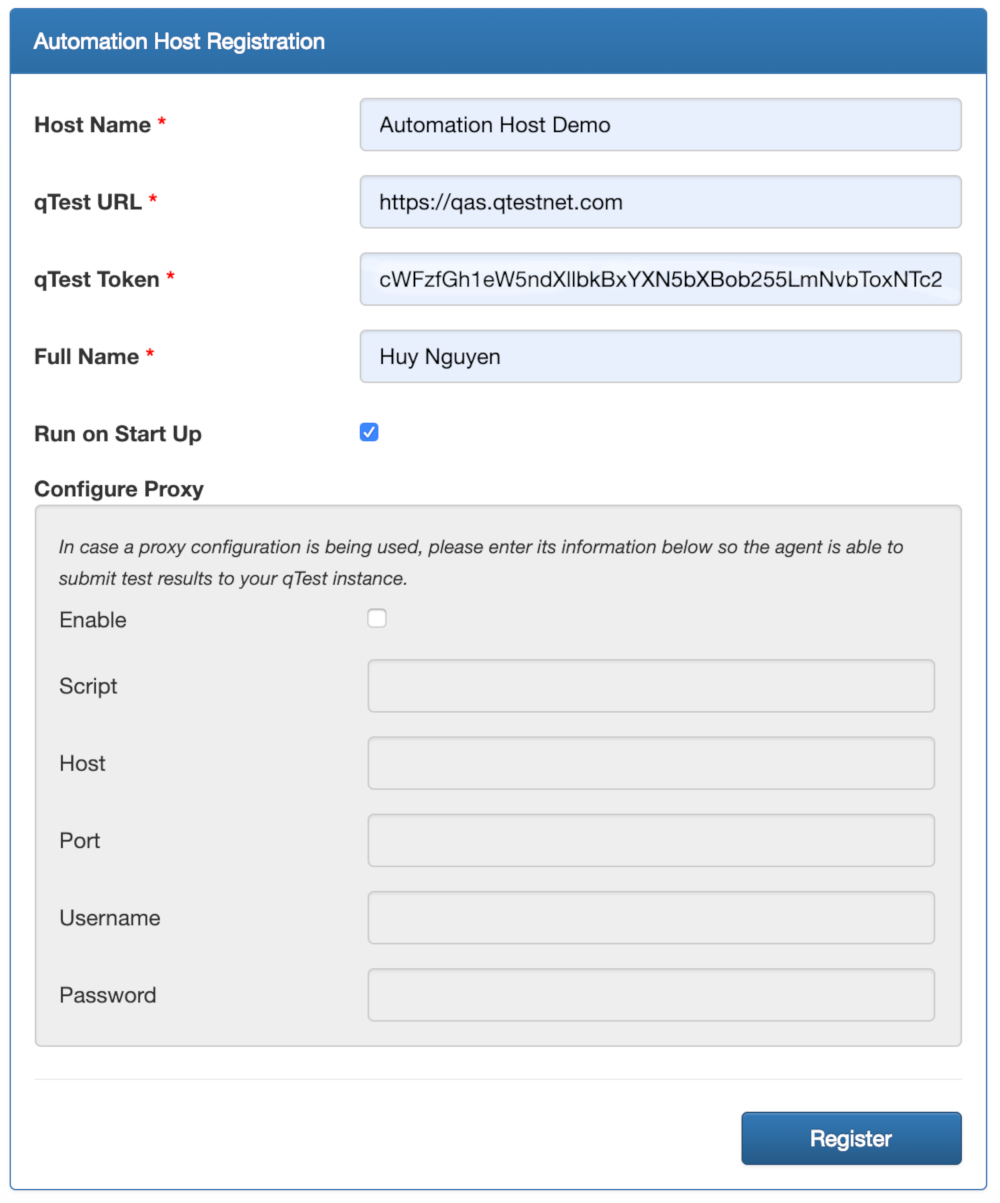qTest Automation Host 2023.6.6 Installation Guide on Linux
In this article, we will walk you through how to install the qTest Automation Host version 2023.6.6 on a Linux machine.
Before you start to integrate qTest Automation Host with Launch, make sure you turn on automation integration.
Download qTest Automation Host 2023.6.6
-
From the Download qTest Automation Host page, download the qTest Automation Host 2023.6.6 for Linux.
We highly recommend that you download the latest version to benefit from bug fixes and enhancements. -
Open the Terminal.
-
Copy the downloaded file agentctl-[version]-linux-x64-full.tgz to a desired installation directory, such as /usr/local/agentctl-[version]-linux-x64-full.tgz.
If you plan to install multiple Automation Host instances on Linux. it is important that you create a parent folder for each instance to easily identity the instance as well to avoid issues when upgrading each instance. The best practice is to suffix parent folder with a number.Example
-
Instance #1: /usr/local/qTest-automation-host-1/agentctl-[version]-linux-x64-full.tgz
-
Instance #2: /usr/local/qTest-automation-host-2/agentctl-[version]-linux-x64-full.tgz
-
...
-
Instance #N: /usr/local/qTest-automation-host-N/agentctl-[version]-linux-x64-full.tgz
Replace [version] in the command to the actual version that you have chosen to download, such as 2023.6.6.
-
-
Change the current directory to the installation directory.
Example
$ cd /usr/localor if you are going to install multiple Automation Host instances
$ cd /usr/local/qTest-automation-host-N -
Extract the bundle:
$ tar -zxf agentctl-[version]-linux-x64-full.tgz -
Change the current directory to the extracted agentctl:
$ cd agentctl-[version]
Acquire your qTest API Token
-
Log in to qTest Manager as an Administrator and access the Resources page.
-
Expand the APIs and SDK section.
-
Copy the API Token, as shown below:

Notes about qTest API token changes
The token will be automatically changed by qTest Manager if below events occur:
-
Users change their password in qTest Manager
OR
-
Users switch authentication type, such as from authenticating with qTest using Username and Password to SSO or LDAP.
Install and Configure the Automation Host
There are two options to install and configure the Automation Host:
Install and configure the Automation Host on Linux via Command Line
From the Terminal, execute the following command to configure the Automation Host:
/path/to/agentctl-[version]> agentctl config -Phostname="[automation_host_name]" -Phost=[ip_address or computer name] -Pport=[agent_port] -PqTest.url=[qTest_url] -PqTest.token=[qTest_token] -Pautostart=[true|false] -Pproxy.enable=[true|false] -Pproxy.host=[proxy_host] -Pproxy.port=[proxy_port] -Pproxy.username=[proxy_username] -Pproxy.password=[proxy_password] -Pproxy.script=[proxy_script_url]
Command Parameters and Descriptions:
| Parameter Name | Description |
|---|---|
| config | Execute the configuration command |
| -Phostname |
Name of this Automation Host instance. If your Automation Host has been installed and started successfully at least once, you will not be able to change your Automation Host name afterward with the `./agentctl config -Phostname="Your new host name"` command. However, you can change your Automation Host name in the Automation Host UI or in qTest Launch (for Elite users).
|
| -Phost |
The actual IP address or computer name of this machine. If this parameter is omitted, localhost will be used. Notes
|
| -Pport | Specify a port that your Automation Host will be running on. If this parameter is omitted, port 6789 will be used. |
| -PqTest.url | URL of your qTest Manager instance. |
| -PqTest.token | The qTest API token generated for your qTest Manager account. You can copy it from the API & SDK section in qTest Manager's Resource page. |
| -Pautostart | Possible value is true or false. If the value is true, the Automation Host will automatically start when system starts up. Default value is false. |
| -Pproxy.enable | Possible value is true or false. If the value is set to true, you will need to provide proxy settings. Otherwise, set it to false. |
| -Pproxy.host | The IP address or machine name of the proxy server. This parameter is required when -Pproxy.enable parameter is set to true. |
| -Pproxy.port | The port that the proxy server is running on. This parameter is required when -Pproxy.enable parameter is set to true. |
| -Pproxy.username | If your proxy server requires basic authentication, enter the username to authenticate with the proxy. |
| -Pproxy.password | If your proxy server requires basic authentication, enter the password to authenticate with the proxy. |
| -Pproxy.script | If your proxy server is configured with a script, enter the URL to access your PAC (Proxy Auto-Configuration) file. |
Configure qTest Automation Host without Proxy
The following example command shows how to configure the qTest Automation Host 2023.6.6 in a non-proxy environment.
Example
/path/to/agentctl-[version]> agentctl config -Phostname="My Automation Host" -Pport=6789 -Pautostart=true -Pproxy.enable=false -PqTest.url=https://demo.qTestnet.com -PqTest.token=(Your API token)
Notes
-
-Phost parameter is omitted.
-
-Pautostart parameter is added.
Configure qTest Automation Host with Proxy Settings
The following example commands show how to configure the qTest Automation Host in a proxy environment. The values for each parameter are highlighted in bold.
Example
/path/to/agentctl-[version]> agentctl config -Phostname="My Automation Host" -Pport=6789 -Pautostart=true -PqTest.url=https://demo.qTestnet.com -PqTest.token=( Your API token) -Pproxy.enable=true -Pproxy.host=192.168.76.138 -Pproxy.port=3128
Notes
-
-Phost parameter is omitted.
-
-Pautostart parameter is added.
If your proxy does require basic authentication with username and password
Example
/path/to/agentctl-[version]> agentctl config -Phostname="My Automation Host" -Pport=6789 -Pautostart=true -PqTest.url=https://demo.qTestnet.com -PqTest.token=(Your API token) -Pproxy.enable=true -Pproxy.host=192.168.76.138 -Pproxy.port=3128 -Pproxy.username=proxyuser@qasymphony.com -Pproxy.password=s0mething#0923
Notes
-
-Phost parameter is omitted.
-
-Pautostart parameter is added.
If your proxy is configured with a script
Example
/path/to/agentctl-[version]> agentctl config -Phostname="My Automation Host" -Pautostart=true -Pport=6789 -PqTest.url=https://demo.qTestnet.com -PqTest.token=(Your API Token) -Pproxy.enable=true -Pproxy.script=https://proxytestlab.sampleproxy.com/proxy.pac
Notes
-
-Phost parameter is omitted.
-
-Pautostart parameter is added.
Start the Automation Host
If you specified Automation Host name in config command (detailed above). Execute this command:
/path/to/agentctl-[version]> agentctl start
Otherwise, execute the command below to start the host AND give your Automation Host a descriptive name.
/path/to/agentctl-[version]> agentctl start -Phostname="[Automation Host name]"
Example
/path/to/agentctl-[version]> agentctl start -Phostname="My Automation Host"
Notes
-
It might take some time for the Automation Host to fully start the first time
-
If you run "agentctl.bat start" by itself, without a -Phostname parameter AND you did not specify host name in previous config command, "Sample Agent" will be used as the default Automation Host name.
-
Once the Automation Host name is set, this name CANNOT be changed in the Terminal. However, you can change it from Automation Host UI or from qTest Launch.
Install the Automation Host as Service on Linux via Command Line
If you want the Automation Host to automatically start when system starts, there are two options:
-
Install Automation Host as a service.
OR
-
Configure it to run at system start up (highly recommended for Automation Host 2.2.2+).
Install qTest Automation Host as a single Service on Linux
If you are using Automation Host 2.1.1 or later AND you want to install multiple instances of Automation Host as services on Linux, proceed to the next section.
Access the agentctl directory and execute following commands:
-
If the Automation Host is running in the Terminal, press Ctrl + C to stop it.
-
Execute the following command to install the Automation Host as a service:
\path\to\agentctl-[version]$ sudo ./install -
Verify whether the service is installed successfully with the following command.
\path\to\agentctl-[version]$ sudo systemctl status qTest-automation-agentIt may take some minutes for the service to fully start for the first time. After that, you can access the host UI using your browser.
Install Multiple qTest Automation Host Instances as Services on Linux
Follow the steps below if you want to install multiple Automation Host instances as services on Linux.
-
Extract the downloaded Automation Host package to multiple directories. Make sure you create a parent directory for each Automation Host instance to easily identify it as well to avoid issues when upgrading that instance. The following example shows how we extract each package inside a parent directory whose name is suffixed with a number.
-
Instance #1: /usr/local/qTest-automation-host-1/agentctl-[version]
-
Instance #2: /usr/local/qTest-automation-host-2/agentctl-[version]
-
...
-
Instance #N: /usr/local/qTest-automation-host-N/agentctl-[version]
-
-
Access each directory, then perform steps 3-5 for each directory.
-
Install and Configure the Automation Host.
Make sure you give each instance a unique Port number via -Pport parameter. It is also highly recommended to give each instance a unique Automation Host name via -Phostname parameter in config or start command. -
If the Automation Host is running in Terminal, stop it with the following command.
.\agentctl stop
-
Execute the following command to install the host as a service. You must give the service a unique name via <service name> parameter.
\path\to\agenctl-[version]$ sudo .\install "<service name>"
Install and configure Automation Host via web interface
As of 2023.6.6, the Automation Host UI is automatically disabled, as we've moved all of your regular functions to Launch for a more secure experience.
While you can manually turn on the UI to install and configure the Automation Host via the web interface, we recommend that you perform these actions via command line.
-
From the Terminal, execute the following command:
\path\to\agentctl-[version]$ .\agentctl start -
Then, execute the following command to turn on the UI:
.\agentctl config -Pui.enabled=true
As of 2023.6.6, the Automation Host UI only runs on the localhost, not on the local network. To access the UI on the network, update the configuration to ./agentctl config -Pui.ip=all. To restrict access back to the localhost, change the configuration to ./agentctl config -Pui.ip=localhost.
-
Wait a couple of minutes for the Automation Host to fully start. Open a web browser and navigate to http://localhost:6789. You'll see the registration UI being shown, as below.

-
Enter information to register the automation host:
Host Name: Enter a meaningful name for the host
qTest URL: Your qTest Site URL
qTest Token: Enter the token from Acquire your qTest API Token
Full Name: Your full name
Configure Proxy: If you are connecting to the internet through your corporate proxy, select the Enable check box to enable proxy configuration.
Script: If your proxy server is configured with a script, enter the URL to access your PAC (Proxy Auto-Configuration) file.
Host: Enter the proxy host address. This can be either the IP address, computer name, or dns name of this proxy server.
If you specify both Script and Host, the Automation Host will connect to the script-based proxy server first, then connect to the proxy host if the connection to the script-based one failed.Port (Required): Specify the port that the proxy server is running on.
Username: If your proxy server requires basic authentication, enter a username to authenticate with the proxy. Otherwise, leave this field empty.
Password: If your proxy server requires basic authentication, enter a password to authenticate with the proxy. Otherwise, leave this field empty.
Run on Start Up: Select this option to automatically start the Automation Host when the machine starts.
-
To turn off the UI, execute the following command in Command Prompt:
.\agentctl.bat config -Pui.enabled=false
Example

Select Register to start registering Automation Host with qTest Manager.
Access qTest Automation Host
Open a browser on another machine and enter the URL: http://<IP address of Linux machine>:<port>
-
IP address of Linux machine: the IP address that you specified during the installation and configuration of the Automation Host.
-
port: the port that you specified during the installation and configuration of the Automation Host. If you did not specify the port, use the default 6789.
Uninstall Service
If you want to uninstall the Automation Host 2.x service, open the Terminal and execute the following commands:
\path\to\agentctl-[version]$ sudo .\uninstall If you installed multiple instances of Automation Host as services on Linux, access each Automation Host directory and execute the above .\uninstall command.